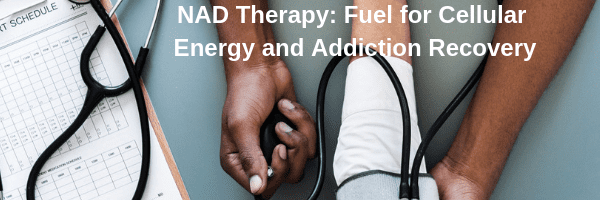 NAD is short for Nicotinamide Adenine Dinucleotide. NAD is derived from vitamin B3 or niacin and is essential for cells to make energy. When a hydrogen atom (H) is attached NAD is converted to active NADH. By then contributing the hydrogen to react with oxygen NADH helps generate energy stored in a chemical form known as ATP or adenosine triphosphate. ATP is fuel for the body, especially heart and skeletal muscle, and brain function.
NAD is short for Nicotinamide Adenine Dinucleotide. NAD is derived from vitamin B3 or niacin and is essential for cells to make energy. When a hydrogen atom (H) is attached NAD is converted to active NADH. By then contributing the hydrogen to react with oxygen NADH helps generate energy stored in a chemical form known as ATP or adenosine triphosphate. ATP is fuel for the body, especially heart and skeletal muscle, and brain function.
Low NAD is associated with numerous conditions including chronic fatigue, weakness and pain, drug and alcohol addiction, anxiety, depression, insomnia, and chronic diseases in general.
NAD given intravenously is a powerful way to restore cellular energy systems, increase energy, and relieve mood disturbances, pain, and addiction.
How does NAD create energy?
The food we eat breaks down to carbohydrates, fats and proteins, all of which results in chemicals that enter the “citric acid cycle”, a molecular roundabout that produces NADH, which is now “charged” and ready to combine with oxygen in the energy producing part of every cell called the “mitochondria”. The mitochondria are little generators that combine hydrogen and oxygen to produce ATP (energy) and water. Cells that need energy have thousands of mitochondria inside.
The enzymes that catalyze energy production as well as the mitochondria itself can be damaged by numerous toxins that cause oxidative or free radical damage, including cigarette smoke, drugs, electromagnetic waves from cell phones and wi-fi, and a plethora of chemicals including pthalates, parabens, pesticides, benzene, styrene, toluene, and more. Even the normal production of energy naturally produces free radicals that can cause oxidative damage to the mitochondria.
Nutritional deficiencies, lack of exercise and chronic stress are also issues that can impair mitochondrial energy production.
By the way… NADH is also known as “CoEnzyme 1” and is necessary to convert CoEnzyme Q10 into an antioxidant. Taking CoQ supplements without adequate NADH misses the full potential of CoQ.
How does NAD work for addiction and mood disorders?
The basis of the NAD and amino acid therapy for addiction and mood disorders is to detoxify the brain and/or replenish the neurotransmitters needed for healthy brain function. NAD provides the energy needed while amino acids supply the building blocks for neurotransmitters such as serotonin, dopamine and norepinephrine. NAD therapy may help quickly detox from drugs and alcohol while avoiding withdrawal cravings and prolonged recovery.
NAD Treatments
I started using NAD with the sublingual form of brand ENADA. There are oral forms available but I’m not sure how well they are absorbed.
NAD is especially powerful when given intravenously by slow IV drip. The IVs take between 3-4 and 8-10 hours depending upon the dosage and the tolerable flow rate. We usually recommend a 3-4 day series for chronic illnesses, fatigue and mood disturbances, and up to a full 8-10 day protocol for drug and alcohol addiction. We also include various amino acids to help restore brain neurotransmitters. It is important to continue on oral NAD supplementation after the IV series.
Author
Scott Rollins, MD, is Board Certified with the American Board of Family Practice and the American Board of Anti-Aging and Regenerative Medicine. He specializes in Bioidentical Hormone Replacement for men and women, thyroid and adrenal disorders, fibromyalgia, weight loss and other complex medical conditions. He is founder and medical director of the Integrative Medicine Center of Western Colorado (imcwc.com) and Bellezza Laser Aesthetics (bellezzalaser.com). Call 245-6911 for an appointment or more information.
